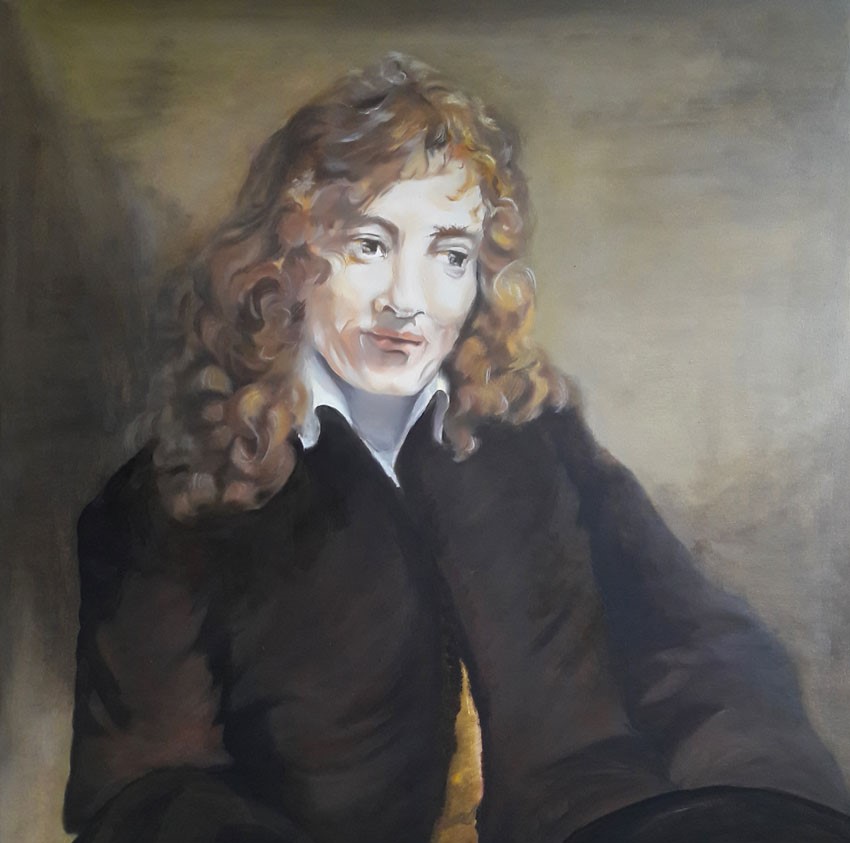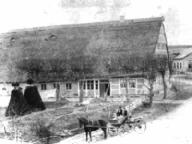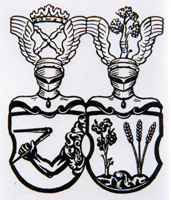A. Schnitger
| Founded/Born - Closed/Death | 1648 - 1719 |
|---|---|
| Still active? | no |
| Webpage | https://www.arp-schnitger-gesellschaft.de/ |
Arp Schnitger came from a long-established and respected family in Schmalenfleth (now a district of Brake/Unterweser). His father was a respected carpenter (in Low German: "Snitker"), who was known to be involved in minor organ repairs.
Arp Schnitger was likely born on July 2, 1648, in the small village of Schmalenfleth, which had a population of about 300. The baptismal entry in the Golzwarder parish archive dates from July 9 of that year.
He grew up with his five siblings in a half-timbered house, which also served as a workshop and had stables for livestock. The successor building stands at Friesenstraße No. 16 in Schmalenfleth. The small one-classroom village school he attended was diagonally opposite. Since Arp Schnitger had knowledge of Latin, it is assumed that he received additional education at the Golzwarder or Ovelgönner Latin school. He then spent four years learning the carpentry trade in his father's workshop.
When the 18-year-old journeyman carpenter bid farewell to his hometown, he took more than just his luggage with him; he carried the foundations for his later remarkable career: a good education, exceptional training in carpentry, musicality, technical understanding, and a thirst for knowledge.
His destination was Glückstadt on the Lower Elbe, where he completed a special five-year apprenticeship as an organ builder under his cousin (or uncle) Berendt Huß, who hailed from Oldenburg. This was followed by five years as a journeyman. Even during this time, Schnitger excelled in his profession, and upon completion of the organ in St. Cosmae, Stade, in 1673, he received a substantial monetary gift from the patrons.
When Master Huß died in 1676 during the construction of the organ in St. Wilhadi Church, Stade, his "Orgel Bauwer Gesell" Schnitger successfully completed the work independently. The church administration also expressed their gratitude with a considerable donation.
After his master's death, Schnitger, at the age of 29, continued the organ workshop in Stade initially on behalf of Widow Huß. Initially, orders came from the surrounding area, but the good reputation of the young, talented master quickly spread. Further tasks called him to the entire region of the former Duchies of Bremen and Verden, as well as to Hamburg.
For five years, from 1677 to 1682, Schnitger worked in his workshop in Stade. He then moved to Hamburg, where he set up his organ building workshop and took the citizen's oath because the renowned music city awaited him with an honorable task: he was commissioned to build the largest organ ever made in Germany for St. Nicolai Church. In almost five years of work, Arp Schnitger and his apprentices created a true masterpiece that would establish his fame. This organ, with 67 registers, four manuals, and pedal, had more than 4000 pipes, the largest of which, the 32-foot C, weighed a considerable 860 pounds. Due to its solid construction and wonderful sound, this organ represented a pinnacle of organ building and marked a decisive step in the young master's career.
Organ experts and composers flocked to the Hanseatic city because this instrument caused a sensation. Even the most famous organ master and composer of the time, Dietrich Buxtehude, took leave to inspect and play the instrument. Georg Friedrich Händel and Johann Sebastian Bach later traveled to the large Schnitger organs and were enthralled by the unprecedented richness of sound.
Schnitger was now known even in the small North German parishes, and orders came from the entire northwestern German region and the Netherlands. His sphere of activity even reached England, Russia, Spain, and Portugal; for the time, this was almost worldwide activity.
The encounter with the composer, organist, and organ expert Vincent Lübeck (1654-1740) can be considered a true stroke of luck. In decades of collaboration and friendship, both experts were able to complement each other and implement each other's suggestions.
In the meantime, Schnitger had married the wealthy Hamburg merchant's daughter Gertrud Otte. He probably met her in Neuenfelde near Hamburg, where her father owned a farm and where Schnitger was building a new organ. From around 1705 until his death in 1719, Schnitger maintained another organ workshop on this farm, the so-called "Organ Builder's Court".
The couple had six children. All four sons followed in their father's footsteps, but only two of them would outlive their distinguished father and continue his work. Franz Caspar worked in the Netherlands after Arp Schnitger's death in 1719.
After Schnitger's first wife died in 1707, he married for the second time in 1713. He had met Anna Elisabeth Koch, the widow of an organist, while working on the organ in Abbehausen (Wesermarsch).
Schnitger's extensive sphere of activity was not only due to his outstanding quality of work but also to the organ builder privileges granted for the Counties of Oldenburg and Delmenhorst (1699), the Duchies of Bremen and Verden (1699), and the Principalities of Schleswig and Holstein (1702). Additionally, he was appointed as the Prussian Court Organ Builder in 1708. Along with well-maintained relationships with the Free Imperial Cities and influential families in the Groningen region, Schnitger's almost monopolistic position in North German organ building can be almost stated.
Arp Schnitger was likely born on July 2, 1648, in the small village of Schmalenfleth, which had a population of about 300. The baptismal entry in the Golzwarder parish archive dates from July 9 of that year.
He grew up with his five siblings in a half-timbered house, which also served as a workshop and had stables for livestock. The successor building stands at Friesenstraße No. 16 in Schmalenfleth. The small one-classroom village school he attended was diagonally opposite. Since Arp Schnitger had knowledge of Latin, it is assumed that he received additional education at the Golzwarder or Ovelgönner Latin school. He then spent four years learning the carpentry trade in his father's workshop.
When the 18-year-old journeyman carpenter bid farewell to his hometown, he took more than just his luggage with him; he carried the foundations for his later remarkable career: a good education, exceptional training in carpentry, musicality, technical understanding, and a thirst for knowledge.
His destination was Glückstadt on the Lower Elbe, where he completed a special five-year apprenticeship as an organ builder under his cousin (or uncle) Berendt Huß, who hailed from Oldenburg. This was followed by five years as a journeyman. Even during this time, Schnitger excelled in his profession, and upon completion of the organ in St. Cosmae, Stade, in 1673, he received a substantial monetary gift from the patrons.
When Master Huß died in 1676 during the construction of the organ in St. Wilhadi Church, Stade, his "Orgel Bauwer Gesell" Schnitger successfully completed the work independently. The church administration also expressed their gratitude with a considerable donation.
After his master's death, Schnitger, at the age of 29, continued the organ workshop in Stade initially on behalf of Widow Huß. Initially, orders came from the surrounding area, but the good reputation of the young, talented master quickly spread. Further tasks called him to the entire region of the former Duchies of Bremen and Verden, as well as to Hamburg.
For five years, from 1677 to 1682, Schnitger worked in his workshop in Stade. He then moved to Hamburg, where he set up his organ building workshop and took the citizen's oath because the renowned music city awaited him with an honorable task: he was commissioned to build the largest organ ever made in Germany for St. Nicolai Church. In almost five years of work, Arp Schnitger and his apprentices created a true masterpiece that would establish his fame. This organ, with 67 registers, four manuals, and pedal, had more than 4000 pipes, the largest of which, the 32-foot C, weighed a considerable 860 pounds. Due to its solid construction and wonderful sound, this organ represented a pinnacle of organ building and marked a decisive step in the young master's career.
Organ experts and composers flocked to the Hanseatic city because this instrument caused a sensation. Even the most famous organ master and composer of the time, Dietrich Buxtehude, took leave to inspect and play the instrument. Georg Friedrich Händel and Johann Sebastian Bach later traveled to the large Schnitger organs and were enthralled by the unprecedented richness of sound.
Schnitger was now known even in the small North German parishes, and orders came from the entire northwestern German region and the Netherlands. His sphere of activity even reached England, Russia, Spain, and Portugal; for the time, this was almost worldwide activity.
The encounter with the composer, organist, and organ expert Vincent Lübeck (1654-1740) can be considered a true stroke of luck. In decades of collaboration and friendship, both experts were able to complement each other and implement each other's suggestions.
In the meantime, Schnitger had married the wealthy Hamburg merchant's daughter Gertrud Otte. He probably met her in Neuenfelde near Hamburg, where her father owned a farm and where Schnitger was building a new organ. From around 1705 until his death in 1719, Schnitger maintained another organ workshop on this farm, the so-called "Organ Builder's Court".
The couple had six children. All four sons followed in their father's footsteps, but only two of them would outlive their distinguished father and continue his work. Franz Caspar worked in the Netherlands after Arp Schnitger's death in 1719.
After Schnitger's first wife died in 1707, he married for the second time in 1713. He had met Anna Elisabeth Koch, the widow of an organist, while working on the organ in Abbehausen (Wesermarsch).
Schnitger's extensive sphere of activity was not only due to his outstanding quality of work but also to the organ builder privileges granted for the Counties of Oldenburg and Delmenhorst (1699), the Duchies of Bremen and Verden (1699), and the Principalities of Schleswig and Holstein (1702). Additionally, he was appointed as the Prussian Court Organ Builder in 1708. Along with well-maintained relationships with the Free Imperial Cities and influential families in the Groningen region, Schnitger's almost monopolistic position in North German organ building can be almost stated.
No YouTube videos available.
Make this Notebook Trusted to load map: File -> Trust Notebook
https://www.arp-schnitger-gesellschaft.de/arp-schnitger/leben-und-werk/
 Pipe Organ Map
Pipe Organ Map

